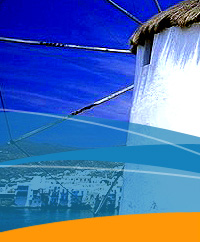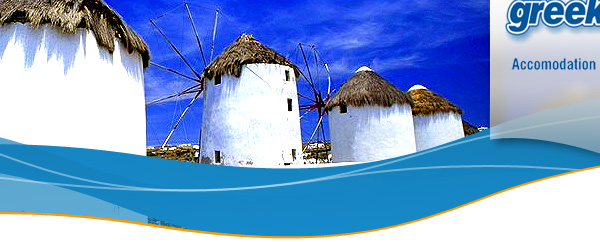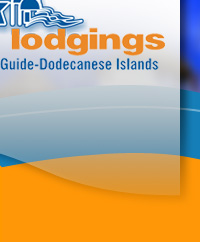|
 |
|
 |
| |
 |
Tilos Island - Dodecanese, Greece
Information on Tilos holidays - Greece |
| |
|
|
 Simple, polite people welcome you as soon as you arrive on the island of Tilos. Tilos island has only 300 inhabitants and very little tourism. Here you will enjoy a quiet life, nature and you will swim in crystal clear waters. The lack of tourism gives you the opportunity to really get to know the locals and become part of their every day life. Don't forget to visit Megalo Chorio where surrounding the central plaza you will see the remains of ancient walls, a necropolis (cemetery), a museum, monasteries and the ruins of a castle. Simple, polite people welcome you as soon as you arrive on the island of Tilos. Tilos island has only 300 inhabitants and very little tourism. Here you will enjoy a quiet life, nature and you will swim in crystal clear waters. The lack of tourism gives you the opportunity to really get to know the locals and become part of their every day life. Don't forget to visit Megalo Chorio where surrounding the central plaza you will see the remains of ancient walls, a necropolis (cemetery), a museum, monasteries and the ruins of a castle.
|
 |
|
 |
 |
 |
 |
About Tilos island! |
|
 |
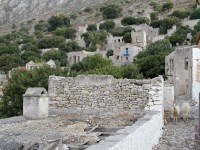 Tilos is situated between the islands of Nissiros and Chalki. It has an area of 64 square kms, a coastline of 63 kms and a distance of 290 nautical miles form the port of Piraeus. The ground is rocky with the only exception being a small fertile valley found almost in the center of the island and which ends up on the idyllic, one kilometer long, sandy beach of Eristos. Today Tilos has 300 inhabitants. The island has two basic settlements Livadia , which is the island's port, and Megalo Chorio. Megalo Chorio is the capital and quite an impressive settlement built as Tilos is situated between the islands of Nissiros and Chalki. It has an area of 64 square kms, a coastline of 63 kms and a distance of 290 nautical miles form the port of Piraeus. The ground is rocky with the only exception being a small fertile valley found almost in the center of the island and which ends up on the idyllic, one kilometer long, sandy beach of Eristos. Today Tilos has 300 inhabitants. The island has two basic settlements Livadia , which is the island's port, and Megalo Chorio. Megalo Chorio is the capital and quite an impressive settlement built as
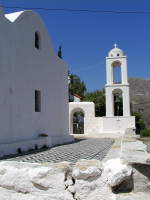 it is at the foot of a rocky hill with the Castle, which built by the Knights of St. John, poised above it. Until early in the 18th century, the entire village resided within the castle walls. more frescoes from the 16th century. In the past years Tilos had more inhabitants and more districts, from which only Megalo Chorio, which is the island's capital and Livadia, the island's port are still inhabited today. At a 2,5 km distance west of Megalo Chorio you it is at the foot of a rocky hill with the Castle, which built by the Knights of St. John, poised above it. Until early in the 18th century, the entire village resided within the castle walls. more frescoes from the 16th century. In the past years Tilos had more inhabitants and more districts, from which only Megalo Chorio, which is the island's capital and Livadia, the island's port are still inhabited today. At a 2,5 km distance west of Megalo Chorio you  can visit the monastery of St. Antonis whlie 6,5 kms NW is the monastery of St. Pandeleimon - the most important monastery of the island. It is estimated that it took its current appearance during the second half of the 15th century and it flourished around the 18th century. It has many frescoes and a pebbled yard. Another settlement of the island, deserted today but while worth visiting is Mikro Chorio. It is postulated that it was built during the Knights era but its inhabitants started leaving it during the 1930 decade. can visit the monastery of St. Antonis whlie 6,5 kms NW is the monastery of St. Pandeleimon - the most important monastery of the island. It is estimated that it took its current appearance during the second half of the 15th century and it flourished around the 18th century. It has many frescoes and a pebbled yard. Another settlement of the island, deserted today but while worth visiting is Mikro Chorio. It is postulated that it was built during the Knights era but its inhabitants started leaving it during the 1930 decade.
|
 |
 |
 |
 About Tilos History About Tilos History |
 |
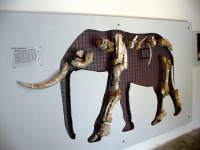 Tilos was first inhabited during the neolithic period. It was invaded and ruled by various tribes such as the Pelasgic and Mycenean people. Concerning its name it is thought that it preserves up to date its ancient name. According to mythology, Tilos took its name from Tilo, the youngest son of Telchinidas Aleas and Helios. On this island Tilo gathered therapeutic plants for his ill wife and later built a temple of which he became the priest. Athough the myth has a charm, the truth about the name like most other islands' names, is that it has an unknown pre-Hellenic origin. On Tilos was born and lived the tender poet Irinna, thοught to be equal to the famous Sapfo - she died at a very early age. During Hellenistic times Tilos was subject to the influence of the mighty state of Rhodes and was finally incorporated into it. In 1310 the Knights of St. John invaded Tilos. The Turks capture the island in 1522 till 1922 that Italians take control. Tilos was incorporated to mother Greece in 1948. Tilos was first inhabited during the neolithic period. It was invaded and ruled by various tribes such as the Pelasgic and Mycenean people. Concerning its name it is thought that it preserves up to date its ancient name. According to mythology, Tilos took its name from Tilo, the youngest son of Telchinidas Aleas and Helios. On this island Tilo gathered therapeutic plants for his ill wife and later built a temple of which he became the priest. Athough the myth has a charm, the truth about the name like most other islands' names, is that it has an unknown pre-Hellenic origin. On Tilos was born and lived the tender poet Irinna, thοught to be equal to the famous Sapfo - she died at a very early age. During Hellenistic times Tilos was subject to the influence of the mighty state of Rhodes and was finally incorporated into it. In 1310 the Knights of St. John invaded Tilos. The Turks capture the island in 1522 till 1922 that Italians take control. Tilos was incorporated to mother Greece in 1948.
Information provided by Archaeologist/Historian/Writter Mr. Haris Koutelakis |
 |
|
| |
| |
|
| |
| [back to top] |
|
 |
|
 |
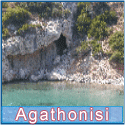 |
 |
| |
 |
| |
| |
| ::: How to get to Tilos island information |

|
 |
 |
Airplane schedules:
There is no air connection to Tilos island.
|
| |
| ::: Ferry Boat and hydrofoil information for Tilos: |
 |
 |
 |
Tilos is connected by sea to the port of Pireaus and to Rhodes.
More information and scedules on Tilos ferry boats and hydrofoils:
Greek Travel Pages
Piraeus Port Authority
Tel: +30 210 4226000
Rhodes Port Authority
Tel: +30 22410 28888/22410 22220 |
| |
| ::: Ferry boat connections from Tilos to other islands: |
 |
 |
 |
Dodecanese Islands:
Agathonissi, Astypalea, Chalki, Kastelorizo, Kos, Leros, Lipsi, Nisyros, Patmos, Pserimos, Rhodos, Symi
Cyclades Islands:
Naxos, Paros
Other Ports:
Chios (North Aegean), Ikaria (Aegean) Samos (North Aegean island)
|
| |
 |
 |
 |
|


